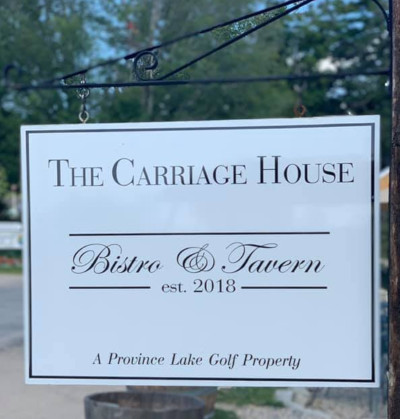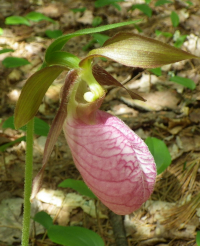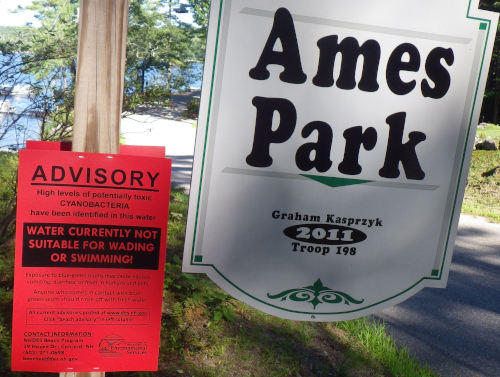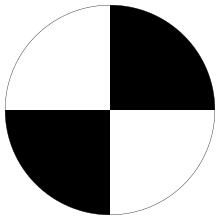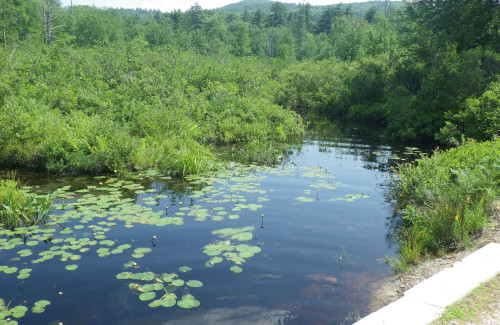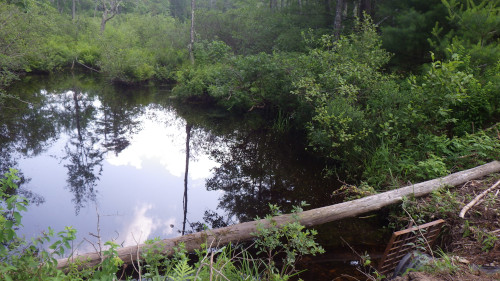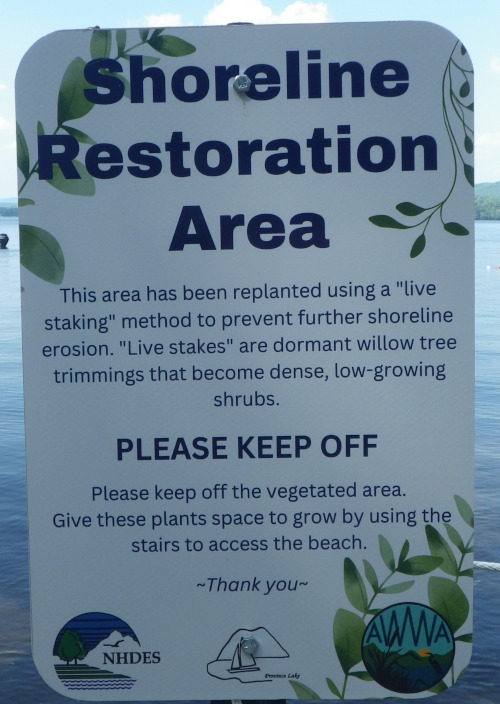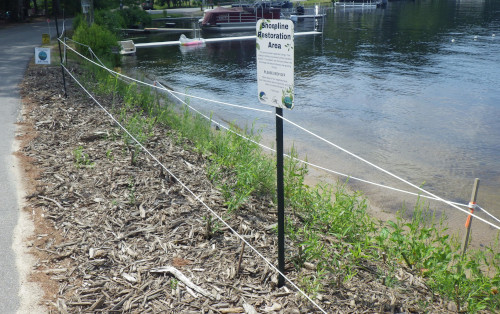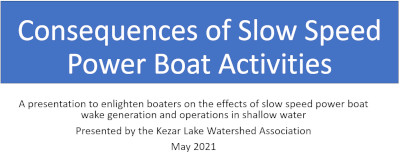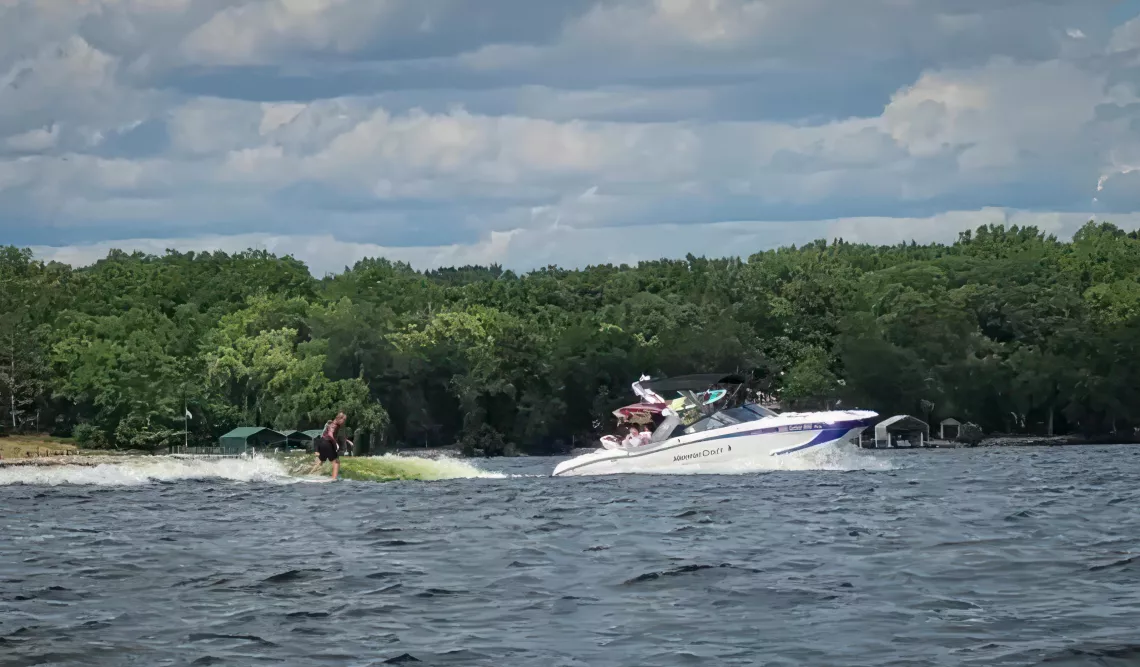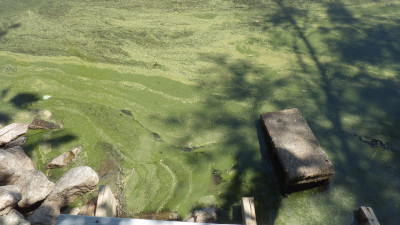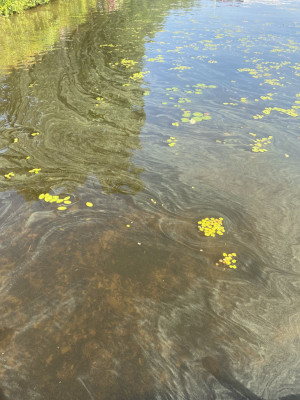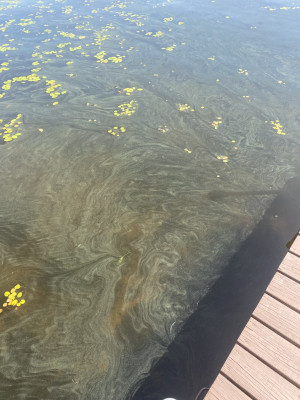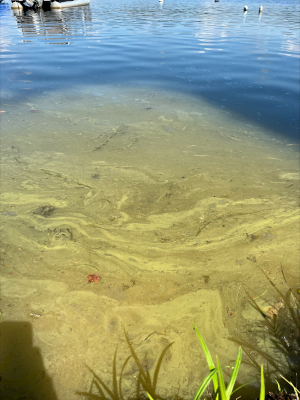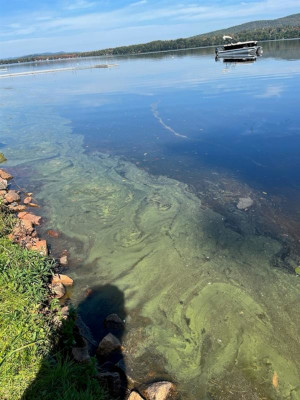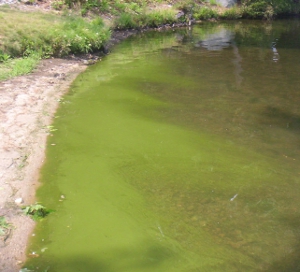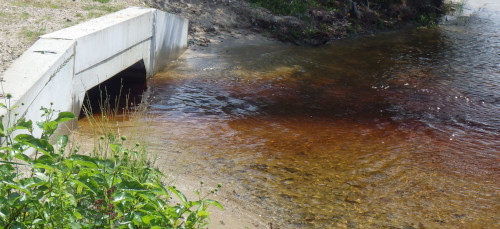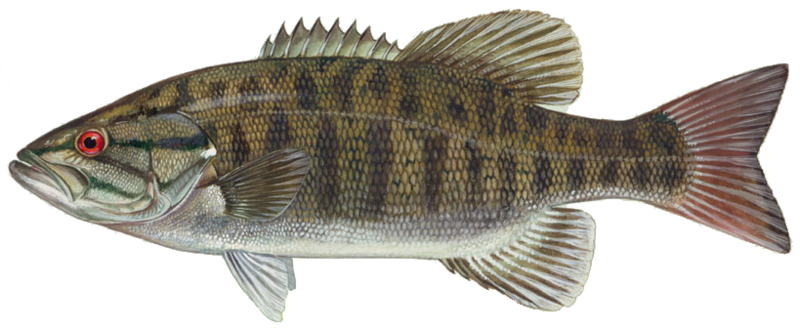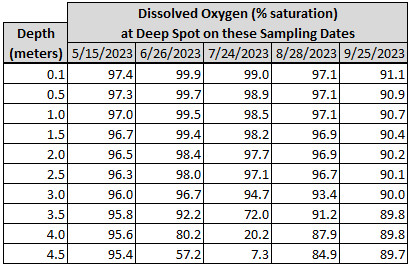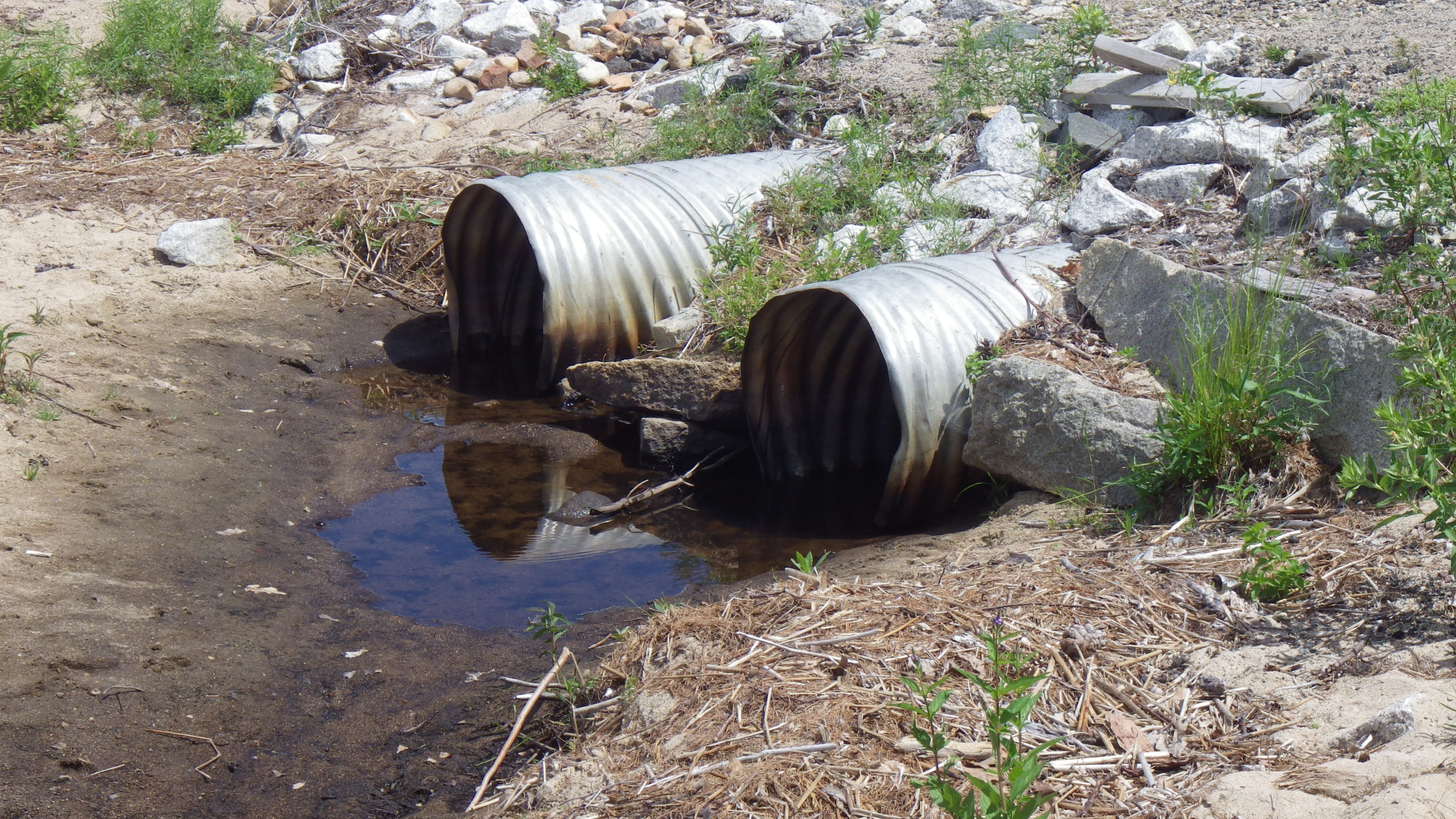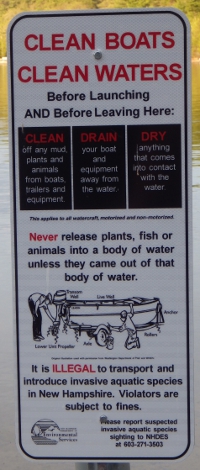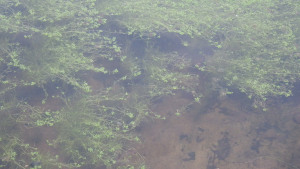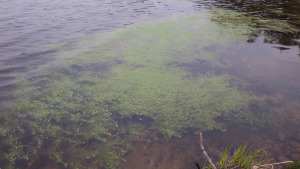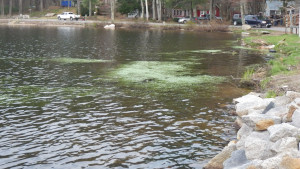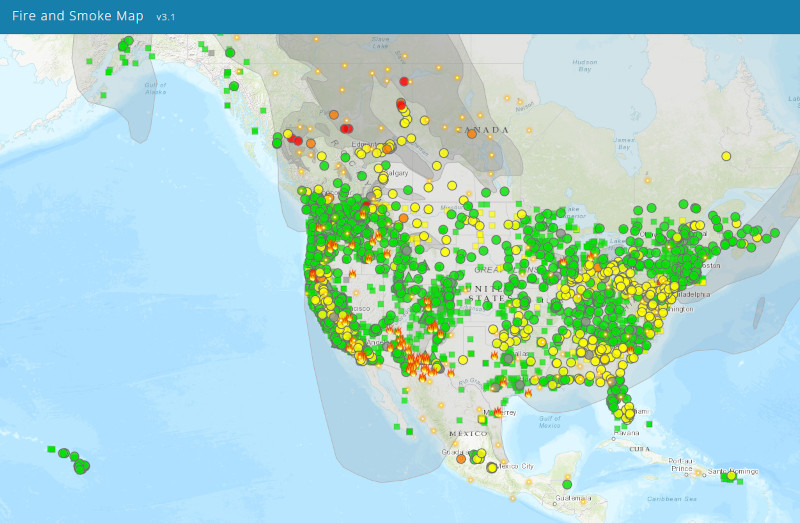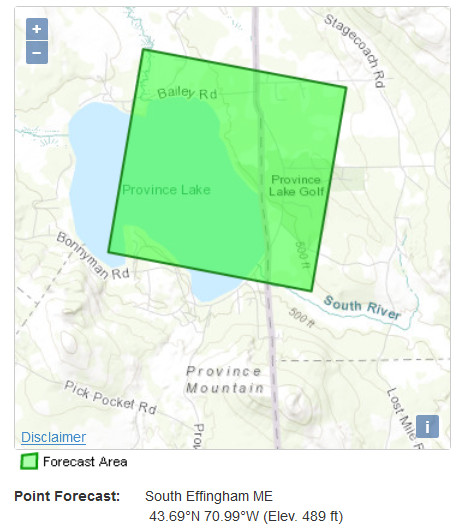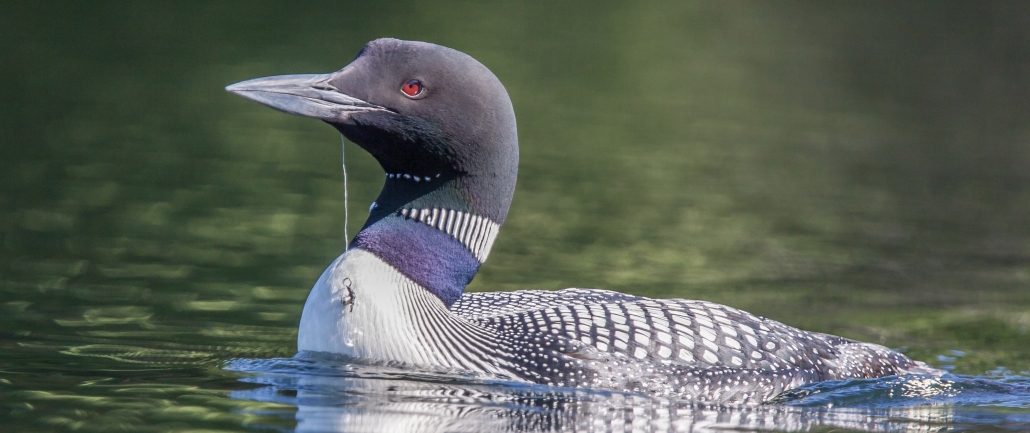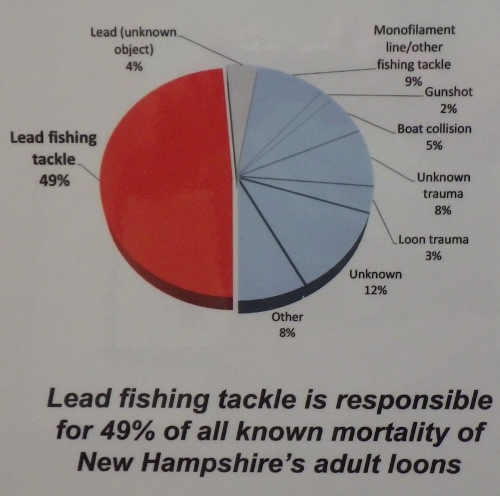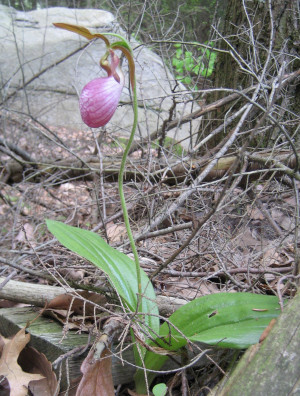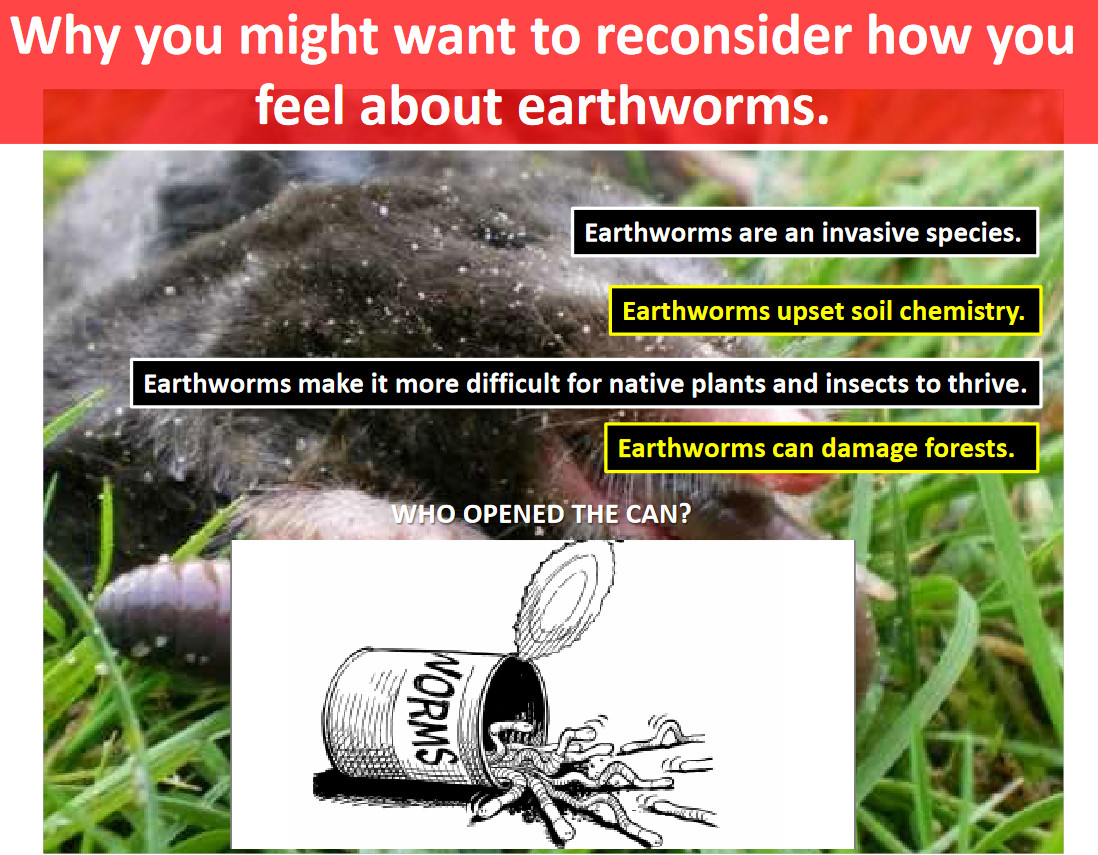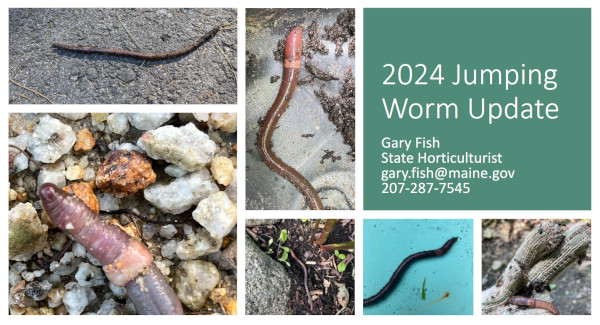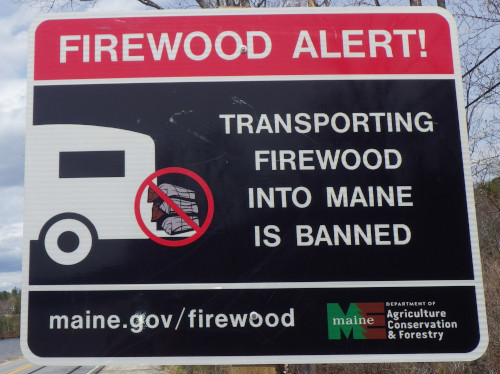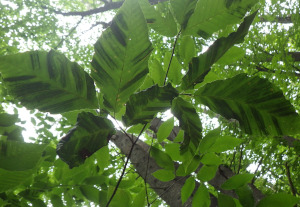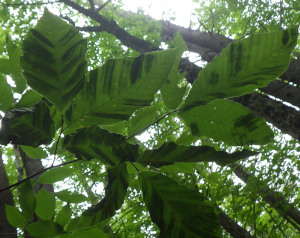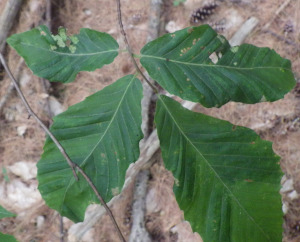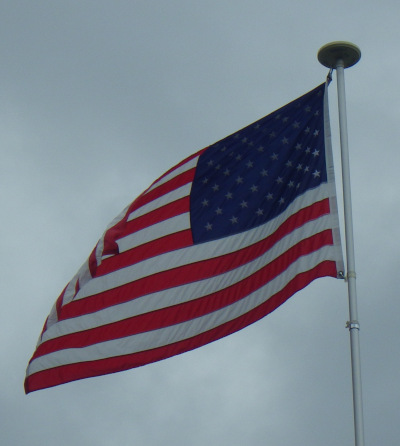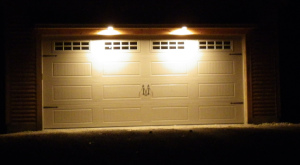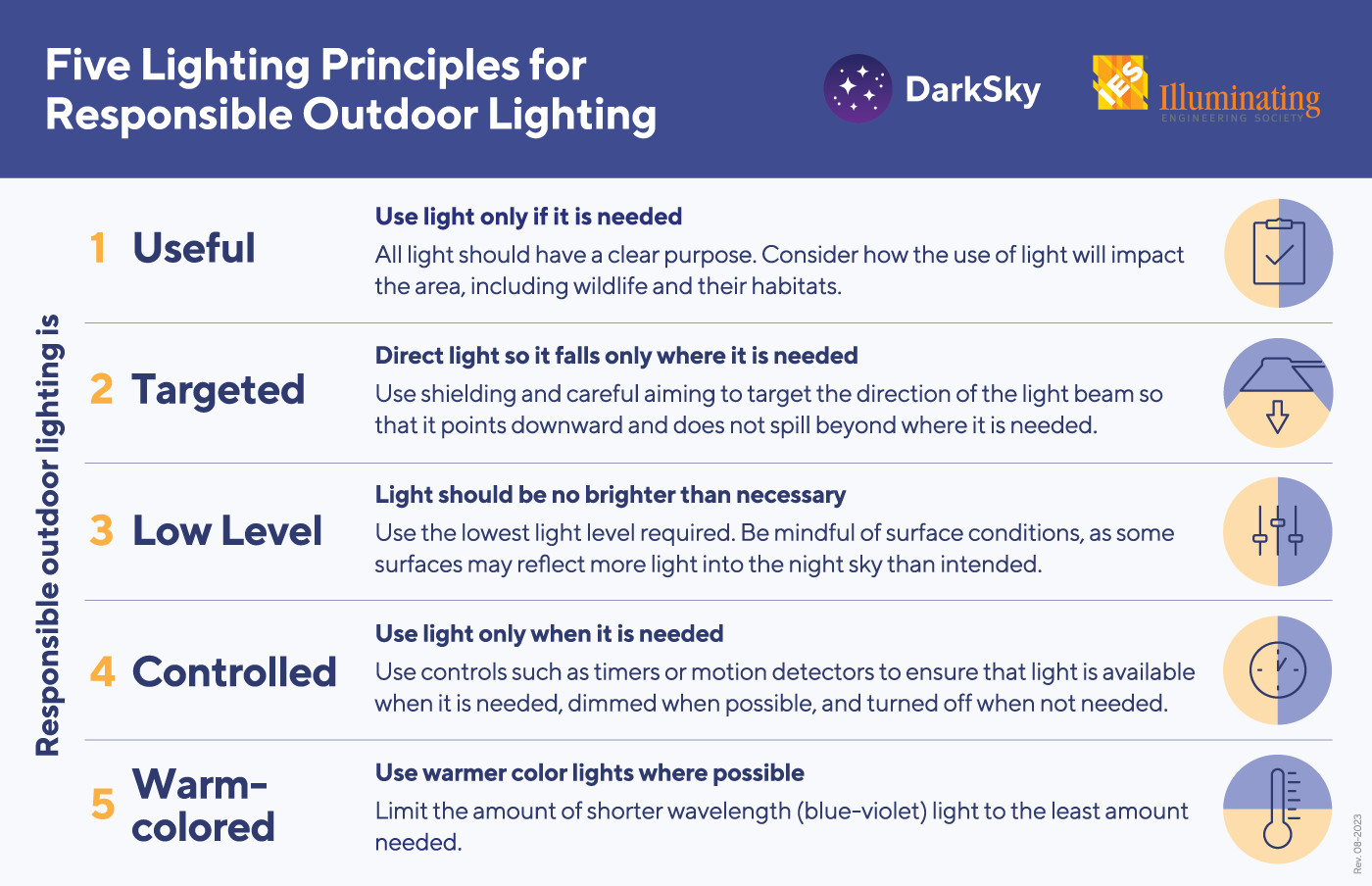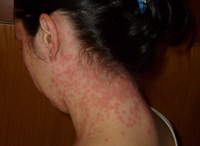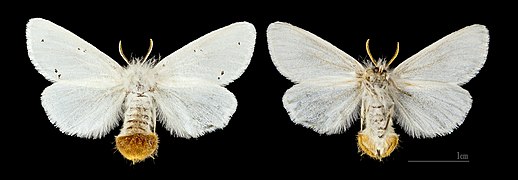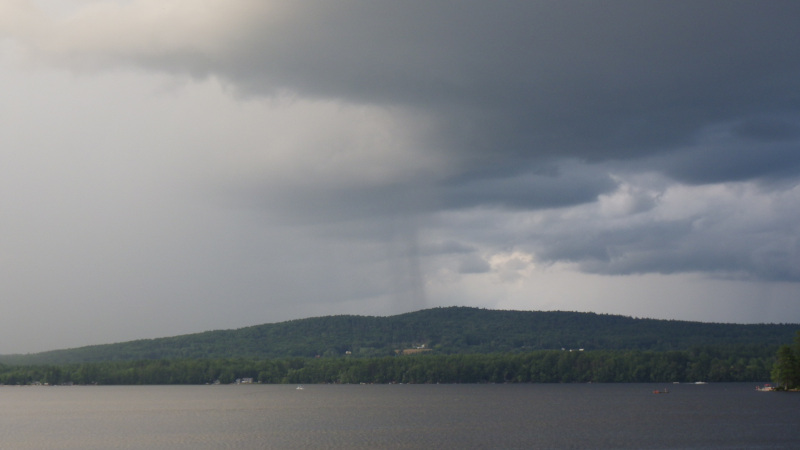Water Quality Monitoring of Province Lake
Effingham & Wakefield, New Hampshire, and Parsonsfield, Maine
2023 Report - Published Online on July 23, 2024
The nearest IQ Air monitoring station to Province Lake is located at the headquarters of the Green Mountain Conservation Group (GMCG):
2023 was the 32nd year of water quality monitoring conducted at Province Lake. The first 23 years of monitoring were conducted as part of the New Hampshire Volunteer Lake Assessment Program (VLAP). In 2014, the Province Lake Association (PLA) switched to the University of New Hampshire (UNH) Lakes Lay Monitoring Program (LLMP). (1) The PLA partners with UNH LLMP and Bob Craycraft for the water quality work. PLA members assist in the coordination and collection of water samples, including providing boats to access the lake site. PLA membership dues finance the water sampling and lab analysis. Without PLA member support, this work would not be possible.
The deep spot was sampled 5 times (mid-May through late September) in 2022. The standard inlets and the outlet were sampled an extra time in early June for a stormwater study, at which time other minor inlets were also sampled just once.
I obtained the 2023 data for analysis directly from Bob Craycraft of UNH Cooperative Extension. Since they send the data to NH Department of Environmental Services (DES) for their Environmental Monitoring Database (EMD), all data are public information. In order to compare 2023 UNH results to prior years, only the June through September data were used in this report; this is consistent with all prior reports.
Many of the terms in this report include hyperlinks to related web sites. By clicking on most of the underlined terms, you can access additional information. Clicking on most photos will get you a large photo with wider angle and higher resolution. To get back to the report from a photo, click the back arrow on your browser or [ALT]+[←] on your keyboard.
Use this menu to jump to a particular topic:
Overall Summary
- Water transparency improved to an average of 2.63 meters (8.6 feet), about 1.3 feet more than in 2022.
- Province Lake had 4 cyanobacteria bloom events in 2023, as reported by the PLA and NH DES via their emails.
The most significant one spanned most of the swimming season, lasting from July 4 to nearly August 31. This was subsequent to having
had 3 more minor blooms in 2022, mostly outside swimming season. The appearance of blooms has been sporadic from year to year since
their emergence in modern times in September 2010.
WARNING: Since Province Lake has a history of cyanobacteria blooms of varying severity, it is advisable to have a look at the water each time you or your children plan to swim. Caution is always advisable. Since a cyanobacteria bloom is readily visible, if you don't see it, swimming is probably safe. If a heavy bloom has just occurred, you might want to wait an extra day or two after it has cleared before swimming.
An excellent source of information about cyanobacteria is this DES web site. - Average phosphorus concentration decreased to the lowest seen since 2013 in the upper layer of the lake.
Chlorophyll-a fell slightly from its high average concentration in the prior year (2022). - The acidity (measured as pH) of both the upper and lower layers of the lake decreased successively in 2022 and 2023 from the surprisingly high acidity that was measured in 2021. This change is good.
Details
This section provides a more detailed look at the 2022 UNH LLMP water quality data for Province Lake. The lake is sampled on dry weekdays to minimize effects of boating and rain.
1. Water transparency (a measure of how deep you can see into the water) was an average of 2.63 meters (8.6 feet) in the deepest part of the lake (16-17 feet deep), an increase of about 16 inches from 2022. This average ranked exactly in the middle of 32 years of data, which by definition is the median average.
We have no information about the transparency in 2020. In an attempt to head off any future data gaps, I created a Province Lake Secchi Club in 2021 and asked for volunteers to take readings from their boats. My hope was to create a more extensive database of Secchi readings, not dependent on a single PLA volunteer. I also hoped to generate a more continuous dataset, where there might not be over a month between readings. I do not have a boat, so the success of this effort was wholly dependent upon members of the Province Lake community obtaining the equipment and taking the readings. The video link on the right shows you the basics of taking a Secchi depth measurement without the use of a viewscope. The reading technique is fully detailed HERE. While I received several messages of support and help with a computer-fillable version of the data form, I have not to date received a single completed datasheet. Anyone is welcome to start doing this at any time. Any data is better than no data.
Please note that I am reporting the transparency that is measured without a viewscope because it represents how most people actually observe the lake. The viewscope method represents how you would see the lake through a diving mask or swim goggles. For comparison, the average 2023 viewscope transparency was 2.95 meters (9.7 feet), also an increase of 16 inches from 2022. The statewide median transparency is 3.2 meters (10.5 feet), without a viewscope. We have a shallow lake, so sediments are easily stirred up, therefore we expect it to be below the state average. The deepest part of the lake is only 16-17 feet (about 5 meters) deep, variable with the lake level, as shown on the NH bathymetric chart.
2. Chlorophyll-a concentrations are used to indicate the average amount of algae and cyanobacteria (2) in the lake. Cyanobacteria are the only bacteria that contain chlorophyll-a, a chemical required for photosynthesis. Notably, sampling during the summer 2023 cyanobacteria bloom did NOT boost the chlorophyll-a concentration measured. The 2023 chlorophyll-a concentrations fell 4% from the 2022 average of 4.27 micrograms per liter (µg/L), to an average concentration of 4.08 µg/L. This is the 9th worst average concentration on record, with all the higher ones (besides 2022) being in the years 1991-2004.
The 2023 average concentration is 89% of the average amount that New Hampshire lakes had. Happily, Province Lake has been below the current NH median chlorophyll-a of 4.58 µg/L since 2005 and has only exceeded it 4 times in 32 years of data. A low level is good because dying algae forms the brown floating bottom masses in July and August. The brown algae masses settle loosely on the bottom when the lake is still and cloud the water when wind or boat wakes stir things up. This may be unsightly, but it is not harmful to people or their animals.
3. Phosphorus is a nutrient required for photosynthesizing organism growth and is typically thought to be the nutrient whose availability most limits plant, algae, and cyanobacteria growth in NH lakes (3). In 2023, the average phosphorus level in the upper water layer (sampled at 2.0 meters depth) decreased by 19% from 2022’s concentration to 14.35 µg/L, its lowest concentration since 2013 and the 12th lowest in 32 years of data. The 2023 level exceeds that in 50% of the lakes in NH, as it usually has.
In the lower water layer (sampled at 4.0 meters depth), the average 2023 phosphorus level was 15.45 µg/L, 20% lower than in 2022. This was the 10th lowest concentration in 22 years of data, since it started to be measured in the year 2000, so about the median average. During 2023, it was 8% higher than that measured at 2.0 meters. the same as in 2022; the deeper sample usually exceeds the shallower sample, so this is normal.
The total phosphorus concentrations over the years have been high enough to earn Province Lake a "Marginal Impairment" listing in the "Aquatic life" use category, ever since NH DES started issuing listings of impairments for phosphorus and chlorophyll-a in 2010. This was first explained in 2013's Issue #5 of the Province Lake Water Newsletter. The 2020 report had the time and space to explain the whole business of Impairments, since there were no new data to analyze for that year. I tried to make it as readable as possible, so please have a look, if you need a review.
The phosphorus concentration at the Rt. 153 Inlet (in NH, near the state line), shown at right, decreased 11% from its 2022 level. That made this the 8th lowest concentration in 32 years of data, which is a good thing.
The average phosphorus concentration measured at the Island Inlet on Bonnyman Road decreased 20% from 2022, making it the lowest in 32 years of data. This is very good. The inland side of the Island Inlet is shown here, at left. The sample is taken where the water flows into the culvert to pass under Bonnyman Road. Volunteers work to make sure this culvert does not stay dammed up by beavers, which could result in water flowing over the road surface.
Ways to Reduce Phosphorus: The erosion control and septic system remediation efforts of the PLA and Acton Wakefield Watersheds Association (AWWA) in recent years are likely to have helped keep phosphorus levels in the lake from increasing more than they have. The Fertilizer Pledge campaign by AWWA and the PLA announced last year is a welcome addition in the effort to protect Province Lake from excess phosphorus. As of this report date, Jon Balanoff at AWWA tells me that about 30 families have committed to the fertilizer pledge! Province Lake is out in the country, not in the suburbs, so there is no need or expectation of picture-perfect lawns. While landowners can take steps to reduce their own phosphorus contributions, there is not one single cause of, and not one simple solution to, high phosphorus levels. It is not like light pollution, which can be fixed at each source by just flipping a switch. These efforts are showing results in reducing phosphorus in both the upper and lower layers of the lake.
It is important to educate lake users on the importance of operating jet skis and boats at minimum headway speed in shallow areas to minimize disturbance to sediments and vegetation.
HERE is a presentation by the Kezar Lake Watershed Association in Lovell, Maine, on the "Consequences of Slow Speed Power Boat Activities." It discusses wakes from all sorts of boats and how they are operated. Slide 22, "Propeller Wash Impact in Lower Bay" features an underwater video that you can access by clicking on the photo on that slide.
HERE is an article from Bart's Watersports, a company that sells watersports supplies, including wakeboards. The article recommends:
- Wake surf boats should operate at least 500 feet from all docks and shorelines, regardless of water depth.
- When producing waves, wake boats should operate at depths of at least 15 feet, but ideally 20 feet or more.
As has been noted, the maximum depth of Province Lake is about 16-17 feet, so Province Lake is simply the wrong place to try to use a wake boat. I can see the conundrum if you have already acquired one, but if you have not already bought one, please JUST DON'T! Pounding the shoreline with excessive wakes (especially when the lake level is abnormally high, as it was in 2023) or churning up the bottom sediments releases phosphorus, which promotes algae, weed, and cyanobacteria growth; increases turbidity (scattering of light by suspended particles), and decreases clarity.
4. Chlorophyll-a versus Phosphorus: See the 2018 report for a statistical analysis of the relationship between Chlorophyll-a and Phosphorus.
5. We had never sampled Province Lake for nitrogen as part of VLAP, but it is included in the UNH Lakes Lay Monitoring Program. Now that nitrogen is being monitored, we have the potential to eventually correlate nitrogen levels with algae growth, as measured by chlorophyll-a. At least 10 years of data are required before a meaningful statistical analysis can be performed. Meanwhile, it would be best not to use nitrogen-containing fertilizers near the shoreline, or streams or ditches feeding the lake, and to be sure septic systems are operating properly. It would also be a tiny help not to pee in the lake while swimming; each time adds about 40 milligrams of nitrogen to the water.
If you have a lush, bright green lawn, it could be a sign to your neighbors and the community that you are fertilizing your lawn, possibly making a significant contribution of nitrogen and/or phosphorus to the lake. On the other hand, if you pump water directly out of the lake to irrigate your lawn, you can contribute to improving the lake water quality by removing nutrients from the water and putting them to use on your lawn; I have been told that some people actually do this here.
6. Province Lake had 4 cyanobacteria events in 2023, as reported by the PLA via their Alert emails. Having timely access to such emails is a good reason to join the PLA. Unfortunately, the longest bloom fell during peak swimming season. Details of the 4 events are listed in the following table, including the dates and sources of information:
| Bloom Dates | Cyanobacteria Bloom Alert Email Excerpts |
|---|---|
| 5/26/2023 |
PLA: "Unfortunately as with some other lakes across NH we are observing early signs of a cyano outbreak. Cyano blooms can look like green mats or
stringers and you may see small green flecks which are mixed in with yellow pollen."
I took the photo at left in front of our place on 5/31/2023. You have seen plenty of still photos of blooms, but the YouTube video link at right shows it moving past our lake stairs on 5/31/2023. |
| 6/1 – 6/8/2023 | NH DES, 6/8/2023: "The cyanobacteria WARNING (ADVISORY) that was issued on 1 June 2023 has been REMOVED for Province Lake, Effingham/Wakefield as of today 8 June 2023. While the bloom accumulation has dissipated, NHDES advises that lake-goers look out for green surface accumulations in the future." |
| 7/4/2023 | PLA: "Unfortunately we are observing early signs of a cyano outbreak." |
| 7/6 – 8/31/2023 |
NH DES: "A cyanobacteria WARNING (ADVISORY) has been issued for Province Lake, Effingham/Wakefield. The bloom was first reported on 4 July,
appearing as light green streaks and ribbons of material on the water. See the 2 images attached [at left and right], taken 6 July. Samples
collected and reviewed on 6 July had cyanobacteria (Dolichospermum)
in concentrations up to 326,000 cells/mL in areas of highest observed accumulations. Advisories are
issued when cell counts exceed 70,000 cells/mL. NHDES advises lake users to not wade or swim in the water during an advisory. Please also keep
pets and livestock out. The advisory is not based on a toxin evaluation and is intended as a precautionary measure for short term exposure."
NH DES 8/3/2023: "Province Lake was resampled today, 3 August 2023. The cyanobacteria density continues to exceed the state limit of 70,000 cell/mL, so the advisory will remain active. Cell densities from five different sampling locations ranged from 12,600 to 1,268,000 cells/mL. The primary taxa present is Dolichospermum. There are now two species of Dolichospermum blooming. Previous to this week there was only one. While some areas had lower density, my sampler today said she visually observed cyanobacteria at every location she sampled. At the lower density sites it appears as flecks in the water, at the higher density areas it is a visible bloom/scum." See the full, much longer email HERE. NH DES 8/10/2023: "Province Lake was resampled today, 10 August 2023. Unfortunately, the cyanobacteria density continues to exceed the state limit of 70,000 cell/mL, so the advisory will remain active. The cyanobacteria density has decreased from last week. Samples ranged from 110,400 cells/mL to 1,800 cells/mL, though most were around 40,000 cells/mL. Please keep signs posted at public access points. NHDES will arrange for sampling again next week. If people ask for updates on the current cyanobacteria advisory status, please direct them to the Healthy Swimming Mapper. If you click on the advisory symbol, you can see our most recent sampling date. When advisories are lifted, the red symbol for the waterbody will no longer be on the map." NH DES 8/17/2023: "Province Lake was resampled today, 17 August 2023. The cyanobacteria density continues to exceed the state limit of 70,000 cell/mL, so the advisory will remain active. The samples ranged from 180,400 to 11,400 cells/mL, however most were in the 100,000 cells/mL range." NH DES 8/31/2023: "Some good news today! The cyanobacteria WARNING (ADVISORY) that was issued on 6 July 2023 has been REMOVED for Province Lake, Effingham/Wakefield as of today 31 August 2023. It was very windy during sampling today, but with no reports of visual accumulations over the past week and today's samples being low density, we are hopeful that the cyanobacteria density has significantly declined. While the bloom accumulation has dissipated, NHDES advises that lake-goers look out for discoloration or surface accumulations in the future." |
| 9/7 – 9/14/2023 |
NH DES: "Unfortunately another cyanobacteria WARNING (ADVISORY) has been issued for Province Lake, Effingham/Wakefield. The bloom was reported again
yesterday, 6 September, appearing as green swirls along the surface of the water. Today when we arrived to sample, the bloom had progressed to thick
yellow/green material at Ames park. See the image attached, taken today 7 September. Samples collected and reviewed today 7 September had
cyanobacteria (Dolichospermum) in concentrations up to 833,335 cells/mL in areas of highest observed accumulations. Advisories are issued
when cell counts exceed 70,000 cells/mL."
NH DES 9/14/2023: "The cyanobacteria WARNING (ADVISORY) that was issued on 7 September 2023 has been REMOVED for Province Lake, Effingham/Wakefield as of today 14 September 2023. The highest observed density was 8733 cells/mL. While the bloom accumulation has dissipated, NHDES advises that lake-goers look out for discoloration or surface accumulations in the future. It was slightly windy during sampling today, and after all the rain the cyanobacteria may return with several sunny days." |
| 10/4 - 10/19/2023 |
NH DES: "Unfortunately, another cyanobacteria WARNING (ADVISORY) has been issued for Province Lake, Effingham/Wakefield. The bloom was first reported on
29 September and an alert was issued. Since then, we have continued to receive reports of green accumulations along shorelines, and flecks of material
lake-wide. See the image attached, taken 3 October. Samples collected 3 October and reviewed today had cyanobacteria (Dolichospermum) in concentrations
up to 492,400 cells/mL in areas of highest observed accumulations. Advisories are issued when cell counts exceed 70,000 cells/mL."
NH DES 10/19/2023: The cyanobacteria WARNING (ADVISORY) that was issued on 4 October 2023 has been REMOVED for Province Lake, Effingham/Wakefield as of today, 19 October 2023." |
Looking at the dates of the start of the 4 blooms, I got suspicious, so I checked my 2023 calendar and made this table to compare the bloom dates with major holidays, which draw above average power boat traffic onto the lake for the long weekends and July 4th week:
| First email about bloom | Holiday | Day & date of holiday |
|---|---|---|
| Friday, 5/26/2023 | Memorial Day | Monday, 5/29/2023 |
| Tuesday, 7/4/2023 | Independence Day | Tuesday, 7/4/2023 |
| Thursday, 9/7/2023 | Labor Day | Monday, 9/4/2023 |
| Wednesday, 10/4/2023 re 9/29/2023 first report | Columbus Day | Monday, 10/9/2023 |
While correlation is not causation, it sure looks like the first 3 blooms were set off by the holiday weekend or week boat traffic. The 4th one is not as clear-cut, but one can imagine folks getting in their "lasties" before the water gets too cold, then that bloom being maintained by the holiday weekend traffic.
We have not seen this pattern every year because 2023 had extraordinarily high lake levels all year, to the extent that the PLA did not install boards in the dam at all to hold water back into the lake. This meant that waves from wakes and wind were pounding on soils that are normally above the lake, not in it. Normally submerged sediments will be somewhat depleted of their phosphorus content, somewhat in equilibrium with the phosphorus content of the water. Soils higher up the bank, not normally directly exposed to the water, will have a higher phosphorus content. This is why erosion from storm-water runoff is considered undesirable, as it allows into the lake soil particles that have a higher phosphorus content. Having an extra vertical foot of shoreline exposed to the water, being pounded by waves, is therefore like storm-water runoff on steroids, with regard to phosphorus.
ANOTHER THOUGHT: Sampling of the lake has always been done on weekday mornings, to avoid too much turbulence caused by boat traffic. When I was directly involved in sampling years ago, we also avoided sampling in stormy weather, although I do not know for sure if that is still the case. In 2023, all sampling was done on Mondays, those being 5/15, 6/26, 7/24, 8/28, and 9/25. You can see that those dates nicely avoided the holidays listed in the table above, although they did allow after-effects from normal weekend boat traffic to linger into the data (which is good). This protocol, seeking quieter times without spikes of turbulence-causing activity, is standard and proper for the purpose of gathering more standardized data that can be compared over time. The issue is that cyanobacteria blooms are not triggered so much in quiet times as they are triggered by spikes in phosphorus in the water during the turbulent times. The irresolvable problem is that it is impractical to measure the phosphorus concentrations during those turbulent times, when the concentrations may vary widely among different locations in the lake. For instance, Ames Park is often the first place a bloom is observed. It is located in a corner of the cove where the boat ramp is located, an area with a higher concentration of boats, which may lead to a higher local concentration of phosphorus.
Province Lake had experienced its first confirmed cyanobacteria bloom since the 1970's in September 2010, then had blooms 4 years in a row (2010-2013). Fortunately, no sightings worthy of a Lake Warning (now called an "Advisory") then occurred from 2014 through 2017. Generally, more frequent blooms have occurred from 2021 onward. See the official NH DES Cyanobacteria Bloom History, which lists official actions and may not capture all blooms that were actually observed by people around the lake.
The continuing blooms mean we are susceptible to having them in future years. When a cyanobacteria bloom is in progress (see description below), there is no way for us to know if it is toxic or not, so we need to act as if it were toxic. Therefore, it is important to know what a bloom looks like and act accordingly. If a cyanobacteria bloom is suspected, there may be Facebook postings and/or PLA email alerts issued. For your convenience, I have added a new "Cyanobacteria Bloom Status" page that will link you to the "Healthy Swimming Mapper", where you can check on the official cyanobacteria bloom status, as posted and updated daily by NH DES. That page can also be found under the "Facts & Photos" tab.
What a Cyanobacteria Bloom Looks Like:
Large concentrations of cyanobacteria (a bloom) would be seen as a green, blue, or pink surface scum in a section of the lake. This is different from the tan or yellowish foam seen sometimes after strong winds. If present in large amounts, cyanobacteria can be toxic to animals and humans. There is some evidence connecting it with increased risk of ALS.
See also this undated article: "CDC warns toxic algae is making people and animals sick",
which reports on illnesses caused by both cyanobacteria and true algae during 2021 in 16 states, none of which are in New England.
While recreational exposure to cyanobacteria toxins is a major concern of NH DES, I only know of one documented case of cyanotoxin-related illness
in New Hampshire (See the 2020 report for details. If you know of other documented cases, please let me know.).
[Photo by NH DES, courtesy of the PLA, 2012.]
If you think you are seeing a cyanobacteria bloom, stay out of the water and especially, keep your children and pets out of the water. Call the NH DES Cyanobacteria Hotline at (603) 848-8094 or email HAB@des.nh.gov or submit a Bloom Report Form to describe what you see. Then call the PLA's phone number, (207) 200-3243, so a sample can be promptly collected. NH DES may analyze the suspected bloom, then post an Advisory if there is any danger. They will monitor the situation and remove the postings when all is clear.
There is a citizen science project of the US Environmental Protection Agency called BloomWatch that anyone can participate in using a smartphone or tablet. You can learn about it and download the app at https://cyanos.org/bloomwatch/ Note that reports to BloomWatch are for citizen science purposes only and do NOT constitute a formal report to authorities, so you would still need to report blooms to NH DES and the PLA, as described above.
A comprehensive yet readable source of information about cyanobacteria is a full presentation by Amanda McQuaid of NH DES called "Cyanobacteria Blooms of New Hampshire", which was given at the 2019 NH Lakes Congress.
According to DES factsheet "Phosphorus: Too much of a good thing", research indicates that cyanobacteria numbers increase as phosphorus in the water increases. Therefore, it suggests the best ways to try to minimize cyanobacteria blooms are to eliminate fertilizer use on lawns, to keep the lake shore natural, to protect against shoreline erosion, and to properly maintain septic systems to prevent leakage. These measures will become more important as the pressure of human population growth results in more land being cleared and developed in the Province Lake watershed. The specific causes of our own blooms is unknown, but preventing future blooms is a major goal of the Province Lake Watershed Management Plan.
Recent PLA Activity: The 2024 PLA annual meeting includes guest speakers who are experts on ways to mitigate cyanobacteria blooms. The board created a subcommittee in the fall of 2023 to look into possible treatment options for when there is a bloom. The subcommittee primarily used the list of options from the US EPA website and dug deeper into options that, at first glance, seem possible for Province Lake.
The table at right (click to see it) is a summary of that work. The first 3 columns are directly from the EPA website. The last three are case studies, additional information and Province Lake potential. They thought it would be good to allow folks to review this before the meeting and therefore provided it in advance via email. Their assessment is that there is no "silver bullet". Any option would require approval and permitting from NH DES, and possible involvement of Maine DEP. Most are very expensive, and to obtain funding through grants etc. will not be quick. The best and longest term solution is to limit the nutrient load into the lake.
I am impressed by the committee's work and salute their efforts! I am posting it on this web site as a public service, to make it more readily available to the entire Province Lake community.
7. A pH between 6.5 to 7.0 is ideal for fish, according to VLAP. pH is the measure of acidity, where 7.00 is neutral, below 7 is acidic, and above 7 is basic. Lab measurements averaged 6.92 in the upper layer and 6.84 in the lower layer, as opposed to 6.76 and 6.74, respectively, in 2022 and 6.53 and 6.50, respectively, in 2021. This showed decreasing acidity during that period from the pH spike observed in 2021, which is a good thing. The state average in the upper layer is 6.6.
The average lab-measured pH at the Rt. 153 inlet was 6.36, a significant improvement over 2022's pH of 5.86. 2023's pH is now the 3rd least acidic in 32 years of data, which is a good thing. This inlet drains a large wetland, which naturally has a high concentration of tannic, humic, and fulvic acids from decomposition of plant life, which give it the color of tea, as shown in the photo at left, and reduce its pH.
The average pH at the Island Inlet was 6.55, less acidic than the 6.31 pH of 2022. It is the 7th least acidic average for this location in 32 years of data. This inlet also drains a wetland.
Exceedances of the Water Quality Criteria for pH are defined as: pH < 6.5 or pH > 8.0. The state average pH of 6.6 is barely better than the 6.5 criterion, therefore a large number of New Hampshire water bodies are listed as "Slight impairment - marginal condition" in the "Aquatic life" use category for pH.
8. Province Lake was listed in 2008 as impaired for mercury in fish and it remains so with all other surface waters in New Hampshire (4). Two fish caught from Province Lake in 2009 were tested in 2010 and shown to have safe mercury levels, but just two fish cannot be assumed to be sufficiently representative of all fish in the lake, especially since 15 years have passed since those fish were caught. It's better to be cautious and do catch-and-release, which leaves more food for the loons and bald eagles.
In January 2023, NH DES reinitiated their Fish Tissue Mercury Monitoring Program. Download a pdf of the details HERE. An important difference in this renewed program is that they want a minimum of 5 individuals in the target size range of the primary species of interest [Yellow Perch (6 – 12 in.), Largemouth Bass (10 – 16 in.), or Smallmouth Bass (shown at right)(10 – 16 in.)]. There is also a list of secondary interest, for which a single individual can be submitted for analysis. Since the fish need to be frozen and hand-delivered to Concord, this would be a perfect citizen science project for a group of anglers on the lake to organize among themselves, in order to do a single delivery run to Concord. The PLA could coordinate this effort, as they did in 2009.
I contacted NH DES to find out if any fish had been submitted from Province Lake since I announced this program a year ago. The response was: "We only have two fish from Province Lake in our Mercury dataset, both being from 2009. One Eastern Chain Pickerel and one Pumpkin Seed." along with the following table:
I hope some Province Lake anglers will heed the call and take up this project this year. When I told DES that I would be promoting this project again, the response was "Thanks a bunch! We are always looking for more samples, especially consistent samples from a waterbody year after year." This surprised me, as I was thinking of it as a one-time deal. So, if you are an avid angler on Province Lake, I encourage you to jump in (figuratively speaking) and make this project your own! If you let me and the PLA know, that would be a way for us to help you avoid duplication of efforts. For now, assume that if YOU don't do it, no one will. Once the analysis is completed (each year, if repeated), please provide me with a copy of the results letter so that the community can see it.
9. Much dissolved oxygen (DO) data were provided by UNH for 2023, most of it good. Much to my surprise, the bottom 1.0 meter of the lake was anoxic during the July 24 reading, something I do not recall seeing before. It recovered nicely by the time of the next reading on August 28. Perhaps this had something to do with the summer-long cyanobacteria bloom. Seeing these two sets of readings shows one of the advantages of the PLA switching to UNH. With VLAP, we got one DO profile per year, at most, so we could not see any changes throughout the sampling season. A high oxygen level is a sign of the lake’s overall good health. Given Province Lake’s large area and shallow depth, it tends to be well-aerated by wind and boats. I encourage powered watercraft to operate fast far from the shore to mix the deep waters and boost the oxygen concentration, while minimizing their use in the shallows.
10. Much E. coli bacteria testing was done in 2013 as part of the study for the Province Lake Watershed Management Plan (see the 2013 supplementary report). Despite some very localized problems with E. coli bacteria in 2013, no E. coli sampling has been performed since then. According to NH DES, if funding and interest exist for further E. coli testing, it can be arranged. As described in the "Secondary Contact Recreation (boating)" section of the 2020 report, new E. coli testing will be necessary to restore Province Lake's "2-G" best rating from its current "3-ND" rating.
Despite the lack of current concerns, it only makes sense that everyone should still stay out of the stream that flows from the golf course and drains into Province Lake at the beach along Rt. 153 near Shore Acres Road in Maine, shown here during a dry period in July 2020. Click photo for wider angle. If you see that water is flowing into the lake at that location, it would be best to avoid swimming too close to it. Canada geese grazing the golf course are almost certainly the source of the E. coli measured in 2013, although that reason does not make the E. coli concentrations safe. Generally, it is probably best to avoid swimming in any streams as they flow into the lake, since even those with E. coli levels considered safe had measurable amounts of bacteria in 2013. Of course, it is always best to avoid swallowing lake water under any circumstances.
11. Scorecards. Regulatory and guidance documents: The 2020 report was primarily about regulatory documents, summarized as succinctly as possible, so I recommend going there to read all about it. No new "scorecards" were available from the NH DES web site when I checked in 2024, so see last year's (2022) report for the last known information on this subject.
A guidance document that I did find (new to me) is the "New Hampshire Non-Point Source Management Program Plan 2020-2024", which has several mentions of Province Lake:
On page 84, it says that four recent watershed-based plans estimated phosphorus contributions from septic systems based on a count of septic systems in the watershed, number of people per housing unit, seasonal occupancy, pounds of phosphorus per person using the system (based upon literature estimates of phosphorus values), and soil retention rates. It found that 17% of phosphorus contributions at Province Lake were from septic systems. This was the least percentage from among the studies conducted at four different New Hampshire lakes (17%, 22%, 27%, and 43%).
Page 97 referenced the "New Hampshire Department of Environmental Services, 2014b. Province Lake Watershed-based Plan, FB Environmental."
On page 100, there was a discussion of the Recovery Potential Screening Tool (RPST), which was developed by EPA as a resource for states to identify areas to focus limited resources among large numbers of non-point source (NPS)-impaired waters. RPST provides a systematic approach for comparing waters or watersheds and identifying differences in how well they may respond to restoration. Using representative ecological, stressor, and social characteristics of each watershed, RPST identifies watersheds in the state with the greatest likelihood of successful water quality restoration efforts. This seemed to be one of the main focuses of the document, which then had the following tables that mentioned Province Lake:
On pages 113 and 116:
The first is the waterway named the South River that flows under Lost Mile Road in Maine, then into Province Lake at what we call the Rt. 153 Inlet. The other is on Bonnyman Road, immediately west of The Point.On page 135:
I did not know exactly what this plan meant for us at Province Lake, so I asked NH DES supervisor Sally Soule, who has been involved with Province Lake in the past, working on the Watershed Management Plan, and whose answers to other questions can be found elsewhere on this web site.
She told me "The nonpoint source program (NPS), which is a non-regulatory voluntary program, runs models to help us estimate the recovery potential of waters based on the following indicators: ecological, social, and water quality. The model output, which is shown in the tables [above], is used to help us evaluate grant proposals. It is not a regulatory table – it is used by our NPS program to help review grants for funding.
"Additionally, the nonpoint source management plan is not a regulatory document – it is a guidance document used by our program to help get grants to folks to do water quality improvement projects like what’s been done on Province Lake over the years. When PLA or AWWA submits a grant application to us, there is a question in the application about where the waterbody ranks in the recovery and protection tables in the NPS plan – points are then assigned where higher recovery and protection potential waters achieve higher points. However, even if something comes up as having "low" recovery potential, the project can still get funding as evidenced by the grants the NPS program has provided for Province Lake over the years. It's really guidance information and should be considered as such – there is no regulatory tie-in."
12. European water-starwort: Callitriche stagnalis, commonly known as either "pond water-starwort" or "European water-starwort", appeared in Province Lake during 2014 and got its first real attention in 2015. It is not native to North America and is ranked "1-Severely invasive" in the Maine Natural Areas Program Advisory List of Invasive Plants - 2019, although not yet in New Hampshire. Its dense weed bed is a threat to native plants that might otherwise grow in that spot, and is also an impediment to swimming in that area. There is an extensive detailed report about the appearance of C. stagnalis in Province Lake published on this web site, with the most recent update in the 2019 report. I have seen that the weed bed is still there in 2024, but I have stopped measuring it because, fortunately, it does not seem to be spreading and local control measures seem to be working. The three photos at above right were taken on May 4, 2024.
Other Environmental Issues for Province Lake and Its Environs
Air Quality and Weather
Starting in 2023, we have been subjected to some poor air quality days due to wildfires in Canada. For your convenience, I have added an "Air Quality" page to this web site where you can find links to a variety of sources providing air quality information locally and for North America, which get updated throughout each day. The Air Quality Index (AQI) widget at the top of this report is among the resources on that page. The Effingham sensor is located at the Green Mountain Conservation Group (GMCG) office. In 2023, I proposed its installation and provided resources to facilitate it, so that we would have data available more locally than Gilford (upwind near the south shore of Lake Winnipesaukee) or the AQI model from Rochester, where there are no sensors. I have also added a new "Weather" page that will take you not only to the National Weather Service forecast for Province Lake, but to an automated weather station located mere feet from the lake and to standardized precipitation data collected daily in town. Both pages can be found under the "Facts & Photos" tab.
Loons and Lead
Most birds swallow small stones to help them digest food. Many fishing sinkers fall into the size range that loons prefer. Being fish-eaters, loons have a lower stomach pH than waterfowl that eat vegetation, such as geese and most ducks. The lower pH more effectively dissolves the lead, which then kills the bird. Poisoning from ingestion of lead objects has been identified as the #1 cause of loon deaths in fresh water. Therefore, most lead fishing tackle has been outlawed for sale or freshwater use in New Hampshire since 2016, so if you still own any lead fishing gear, please stop using it immediately. According to Loon.org, from January 1 through Dec. 31, 2024, or until all vouchers are claimed, anglers can exchange one ounce or more of banned lead fishing tackle for a $10 merchandise voucher redeemable at participating tackle shops. The nearest such shop to Province Lake is Ossipee Bait and Tackle (Facebook link) at 306 Pine River Road in Effingham. Lead tackle can also be dropped off for free at AWWA's office at 254 Main Street, Union, NH. For definitive and up to date information on this subject, please see the Loon Preservation Committee's Loons and Lead web page. Read the Loon Center's full poster on the subject.
Earthworms
If you bring up or buy earthworms to use as fishing bait, you absolutely should not release them on the ground, since they are not native to New England and they can eat up the
leaf litter and disturb the soil. Many native plants, such as lady slippers, require undisturbed soil to live.
HERE is an article, reprinted by permission of Maine Woodland Owners, that describes the threat that the more recently arrived and more aggressive
Asian "jumping worms" pose to our forests. It begins:
"In Maine, all earthworms are non-native. Our forests have developed without them since the time of glaciers, so when earthworms are present, negative outcomes can result."
HERE is the Maine Jumping Worm page. The icon at left will take you to the Maine Dept. of Agriculture, Conservation, & Forestry slide presentation about jumping worms that is very easy to read and tells everything you might want to know on the subject. The icon at right will take you to a single slide that summarizes why you do not want to help earthworms spread their range. Prior years' water quality reports, back to the 2011 report, also provide a variety of information about earthworm threats.
If you have worms for fishing, either use them up or give them to someone else who can use them. Dumping them in the lake is insufficient to dispose of them. Apparently, they can swim to shore and survive. Freezing worms for a few weeks or soaking them in rubbing alcohol (isopropanol) or ethanol (such as vodka) is most effective. If you find euthanizing them in alcohol to be too upsetting to watch, I have been told by a worm biologist that you can soak them in Epsom's salt solution first to relax them. Any soil you had the worms in can contain eggs or other life stages, so should be treated and not be dumped on the ground either. I find the State recommendation to place them in the trash inadequate, as it does not account for the final destination of your trash. Worms might survive a trip to a landfill and escape into the world from there. You only need a few to escape and cause permanent problems. So kill them! The native plants, tree frogs, toads, salamanders, and other little creatures that live in the woods will thank you!
Destructive Wood Pests
Emerald Ash Borer (EAB) is here. The map linked at right (click the icon), updated 3/31/2023, shows that EAB has arrived and that Province Lake is in the EAB General Infested Area, therefore also in the EAB Quarantine Area. Once EAB arrives, it cannot be erradicated, only managed. If you happen to have a significant number of ash trees on your property, it would be prudent to discuss management issues with a forester NOW, so that the value of timber can be realized before it is lost.
BAD NEWS: Beech Leaf Disease (BLD) has reached the Province Lake region as of July 2024. I definitely found it on the site I monitor annually in East Wakefield, NH on the Effingham town line (click the 3 local photos at right). THIS MAP, dated 7/1/2024, shows the northern extent of BLD in New Hampshire being the Town of Wakefield. The site I monitor across the lake in Parsonsfield, Maine did NOT yet have symptoms specifically diagnostic of BLD, although THIS MAP from the Maine Dept. of Agriculture, Conservation, & Forestry, dated 6/30/2024, shows it has been detected in Parsonsfield. I will be surveying my other sites in the region in mid-summer.
BLD has been moving rapidly north along the coast of New England and had made it into coastal New Hampshire and Maine as of 2023. The Province Lake region is among the best monitored regions in northern New England, because I have surveyed it myself for 5 years, but it would be very useful to have others monitor elsewhere. For instance, if you hike away from the lake, you could survey along your favorite trails, especially if they are north of the lake. If Province Lake is your summer weekend place, you could survey back home where you live. Please see the Beech Leaf Disease Project page to read all about it.
BLD can kill a beech tree in just a few years. It might be possible to treat a high-value individual tree in your yard, but it would not be practical to treat trees in the forest.
Please always use local firewood, to keep from spreading around EAB and other wood pests. It is illegal to move firewood across most state lines in the Northeast now, and Province Lake is perched on a state line, so be careful to keep out of trouble. See the 2009 report for more details. You can also learn much more at the following web sites:

- NH Bugs - Damaging Insects & Diseases
- Invasive Threats to Maine's Forests and Trees
- Massachusetts Introduced Pests Outreach Project
- "Emerald Ash Borer: Background & Overview of the Green Menace"
Light Pollution is real, with simple solutions.
Dark Sky International published "Artificial Light at Night (ALAN): State of the Science 2024" on June 4, 2024. You can watch a YouTube video by the author HERE or download a pdf of the report directly HERE. The text and illustrations in the report are just under 14 pages. Below are the brief summaries of the most relevant sections, as copied from the report:
 |
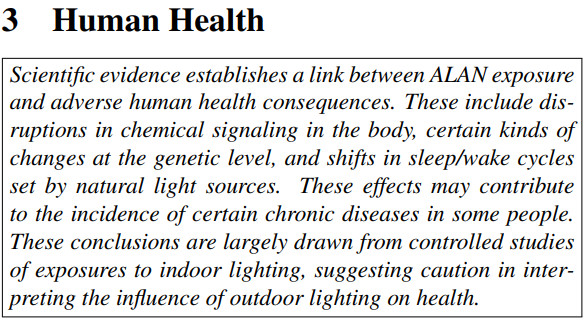 |
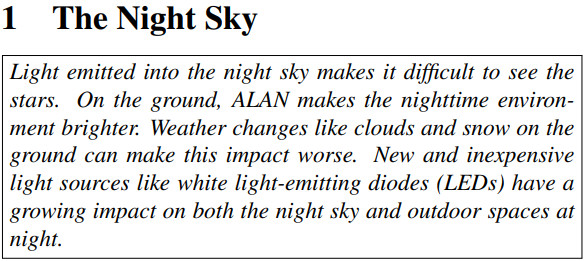 |
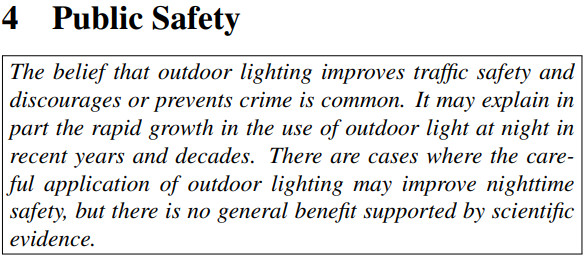 |
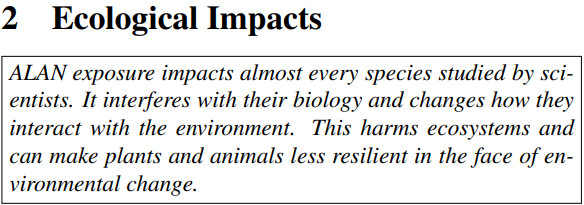 |
 |
At Province Lake, we are fortunate that we can see the Milky Way. According to the 2016 groundbreaking "World Atlas of Artificial Night Sky Brightness", 80% of the world’s population lives under skyglow. Without big commercial or industrial sources of light pollution nearby, is has been up to individual residents to ruin the night views for themselves and everyone else. If you have a beautiful view from your property, please consider that everyone potentially within that area that you can see, can see you back. That is especially so if you live on a mountainside or beside the lake shore. For people in that area, YOU ARE THE VIEW. It is your civic responsibility to minimize your impact on everyone else's view. If security is your concern, there are myriad options to minimize your impact. Lights on motion sensors can startle someone approaching, as well as alerting you that someone is approaching. It is not difficult to aim your lights downward or shield your lights so that they do not shine directly into the eyes of anyone beyond your property line or immediately adjacent roadway.
For more on the negative effects that outdoor lighting has on noctural insects, please see THIS ARTICLE from the Xerces Society for Invertebrate Conservation. That article also mentions that electronic "bug zappers" are still widely available despite the overwhelming body of research demonstrating that they are useless for controlling pests such as mosquitos. It further references THIS ARTICLE, which is welll worth a read. It says: "The main reason bug zappers don't work is that mosquitoes are extremely sensitive to carbon dioxide. They see the UV light in your yard, but once they pick up even the slightest trace of carbon dioxide from people, they change direction and zero in on the source of that odor. They are expert at detecting carbon dioxide at levels as low as 50 parts per million." It also says: "Tests at the UF/IFAS Florida Medical Entomology Laboratory in Vero Beach show that thousands of beneficial insects -- not mosquitoes -- are the main victims of the electric devices. Out of some 10,000 insects destroyed by one bug zapper during a one-night test period, only eight were mosquitoes."
I have teamed up with astronomy professor and local resident Bernie Reim on this project to protect the dark skies we enjoy around Province Lake. I encourage everyone to participate by reading the following principles and taking steps to try to meet them. No one is expecting you to do all of them or to be perfect, but each individual step that you DO take is an improvement that you can notice immediately after dark. You and everyone else will benefit. In most cases, you can make great strides with minimal effort. Rather than costing you money, you are sure to have net savings on your electric bill.
The photo at left shows how the campground is properly lighting the flag located at the end of their dock. The small solar-powered light on top of the pole points downward, illuminating the flag and not much else. The photo at right shows how one person on the lake properly lights their garage door, directing the beams down at the door, not out towards the road or even the driveway, much less across the lake. In addition, these lights are NOT turned on all night long. I was given permission to take and use this photo.
Browntail Moth
Invasive Browntail Moth caterpillars remain a major problem in Coastal Maine. This is not just the typical problem of being bad for trees, but an actual human health issue since shed hairs cause respiratory distress or poison-ivy type rashes. Province Lake is in the "Alert" area of the 2020 Browntail Moth Risk Map, where no detections have been noted. If you find these caterpillars here, the states want to know. Updated detections from the winter web survey can be seen on the Browntail Moth Interactive Map. See the 2018 report for more detailed information. You can learn much more at the following web sites:
Online Resources
I started the Province Lake Water Newsletter in 2013 to cover various topics related to water quality, invasive species, or other issues that have some bearing on the region surrounding Province Lake. I encourage you to sign up for these occasional emails (up to 2 or 3 per year) HERE. Signing up gets you the emailed newsletter only and your information will not be shared with anyone. You can easily unsubscribe or resubscribe at any time.
Last year's water quality report is posted HERE. That is the 2022 report, published online on July 25, 2023. Prior year reports going back to 2009 are also posted online for your reference.
There are now over 2,300 members of the Facebook group called "Province Lake, New Hampshire & Maine" (not affiliated with the any organization), where people interested in the lake and nearby areas can share information. Province Lake Campground and Jolly Roger Village also have Facebook groups primarily for members, and there has been outreach regarding water quality issues by that means. These Facebook groups have been used to post cyanobacteria warnings, official or otherwise.
THANK YOU NOTES: I want to thank Steve Craig for taking the lead on the water sampling activity from 2004 to 2020. Steve has retired from that role and been replaced by Katie Jones since 2021. Thank you, Katie, for taking on this valuable work!
The PLA partners with University of New Hampshire (UNH) Lakes Lay Monitoring Program (LLMP) and Bob Craycraft for the water quality work. PLA members assist in the coordination and collection of water samples, including providing boats to access the lake site. PLA membership dues finance the water sampling and lab analysis. Without PLA member support, this work would not be possible.
The PLA can always use more volunteers to help with sampling, etc. I have been given permission to say you are more than welcome to contact the PLA directly at president@provincelake.org if you want to help them with water quality work, weed watching, or anything else. If you contact me (at province-lake-water@cox.net) to express interest in volunteering, I will also pass on your information. You do not need to be a member of the PLA to volunteer, and have no obligation to join if you do volunteer, although new or returned members are always welcome. Dues are used to support efforts to improve lake quality.
On a more personal note, I have been actively involved in recruiting volunteers for citizen science projects in the last few years. Locally, this has included the Province Lake Secchi Club and Frog Watch. The Beech Leaf Disease Project covers the entire northeast U.S. My Dark Sky efforts are meant to encourage people around Province Lake to be better neighbors, protect the wildlife (of all sizes) in their immediate vicinity, cut their carbon emissions, and save themselves money on their electric bills, all at the same time. The difficulty I have found in finding people to help makes me REALLY appreciate the PLA-associated folks who sample the lake and inlets, patrol the lake as Weed Watchers, inspect boats and trailers for hitch-hiking weeds while they are using the boat ramp, maintain the dam, clean up the beaches, serve on the PLA Board, and do other activities that benefit the environment and other folks. Please join me in appreciating them, but better yet, please join them in doing something. We will all be better off for it!
Thanks for your interest,
Norm Dudziak, P.E., I.M.
See Province Lake statistics HERE.
A sudden rain front advancing across Wiggin Mountain, July 6, 2024.
Footnotes
- While making the change from VLAP to LLMP had multiple benefits, the downside is that the 23-year continuous record of consistent analyses by VLAP has been broken, so data are not always comparable. See the 2015 report for details of the impact, as specifically described by Sara Steiner, NH DES VLAP Coordinator, and the chlorophyll-a section of the 2021 report for an example. A much bigger impact will be due to the lost year of data from 2020, when no sampling of Province Lake was conducted due to pandemic restrictions.
- While some still mistakenly use the term "algae" to refer to cyanobacteria, in this report "algae" is only used to refer to true algae. Cyanobacteria are bacteria, not algae; they are not even in the same biological kingdom. Algae are more closely related to YOU than they are to cyanobacteria! Other than both being microscopic cells, they are fundamentally different. See Footnote #2 of 2013 Newsletter #5 for a detailed explanation.
- "Why the limiting nutrient differs between temperate coastal seas and freshwater lakes: A matter of salt"
- Note 3 of the "Final- 2008 List of All Impaired or Threatened Waters" stated "all surface waters in New Hampshire are also included on this list due to statewide fish/shellfish consumption advisories because of mercury levels in fish/shellfish tissue." The 2016 list includes a similar note. This issue is further explained in Question 1 of the 2012 Supplemental Report.
Legal Disclaimer: I am a degreed environmental engineer, licensed in Maine and other states, but my communications on this topic are educational
in nature. Due to my professional engineering licenses, I am required to say that this communication does not constitute engineering work, even when
using my engineering knowledge. I do not speak for anyone but myself, in the form of my company,
E and I Services, LLC.
Terms of Use: Anyone is allowed, even encouraged, to link to this page. However, no one is
authorized by the author
or by E and I Services, LLC to copy the content and post it on another web site.
This web site is owned by E and I Services, LLC and has no affiliation with any other organization.
Copyright © 2024 by E and I Services, LLC. Copyrights apply to photos resident on this web site, except as noted or if the photos are presented
by linkage to another web site. All rights reserved.
